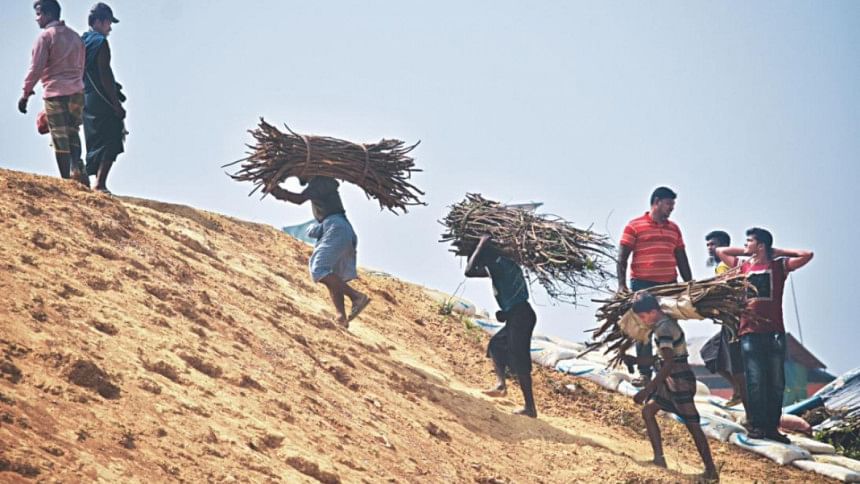Socio-economic impacts of the Rohingya influx

The United Nations Development Programme (UNDP), in association with the Policy Research Institute of Bangladesh (PRI) and the local administration of Cox's Bazar, unveiled the findings of a joint impact assessment study on July 25, 2019. The report titled "Impacts of the Rohingya Refugee Influx on Host Communities" looks at the impact of the massive influx of Rohingyas on the host communities and how it has affected the long-term development needs of Bangladeshis living in the affected areas.
The immediate effect of Bangladesh hosting about a million people on its soil, as pointed out in the report, is that prices of daily essentials have risen by about 50 percent, wages of day labourers have decreased, some 2,500 households fell below the poverty line, about 5,500 acres of reserve forests have been decimated and 1,500 hectares of wildlife habitat destroyed. "The study has used a mix of primary survey data, secondary data from traditional sources and occasionally perceptions based on the researchers' understanding. Key Government of Bangladesh (GoB) agencies engaged in the provision of services to the Rohingya and the host population are identified and their current personnel strength assessed."
That poverty has increased by nearly three percent in the host community is something that is not talked about much. We also learn that about 75,000 people in the host community have become more vulnerable in poverty terms due to the refugee crisis. Day labourers are bearing the brunt of the refugee influx since cheap labour is available from the Rohingya community and a ban on fishing on the Naf River along the Bangladesh-Myanmar border is causing hardship and threatening livelihoods of some 35,000 fishermen and their dependents. These fisher folk families each had, according to the study, an annual income of around Tk 70,000 per annum which has now all but dried up.
The damaging effects of hosting so many people in the areas of some hill districts has had an adverse effect on the local economy. We are informed that the road infrastructure has sustained damage to the tune of about USD 200 million. The study also looks at repatriation costs and here the figures become astronomical! It's estimated that USD 3.2 billion will be required for refugees to return to their home country under the best-case scenario and if we are looking at 600 refugees returning on a daily basis, the process will take five years to complete. The study states, however, that if the number of returnees drops to 200 people a day, the cost will escalate to USD 11.6 billion and the number of years it will take to repatriate the entire refugee population will be 13 years.
In the first three weeks of the influx (in August 2017), Bangladesh received more refugees than all of Europe did in 2016 at the height of the Syrian crisis. Putting that into perspective, Bangladesh which has less than 0.31 percent of the global population, hosts 4.7 percent of its total refugees. Only now has the data become available to gauge the socio-economic burden of this foreign population living on Bangladeshi soil. The researchers used both qualitative and quantitative tools to gather data and information on community perceptions "in order to be able to assess the impacts, as well as secondary sources."
The arrival of the Rohingyas (in three phases) from the Rakhine state started in 1978. The latest wave in 2017 was by far the largest, and the refugee population is estimated at 882,676 or 203,137 families. Children make up more than half the population. The government, with support from the international community, set up temporary settlements for refugees. The political process for their repatriation has been dragging on for the last two years and in the meantime, we have seen its adverse impact on host communities.
Price of rice has increased significantly because rice is also the staple food for Rohingyas. The survey found rice prices in Teknaf and Ukhiya post-influx to be Tk 38 per kg during May-June 2018, lower on average than the national price by Tk 6 per kg (Tk 44 in April 2018).
Survey data shows that mean wages of all labourers declined from Tk 417 pre-influx to Tk 357 post-influx, or a decline of 14 percent in Teknaf (in Ukhiya it was 6 percent). The agricultural wage in Ukhiya is said to have fallen at a much higher rate. Agricultural wage in Teknaf has apparently fallen by 11 percent. These figures tell us that there is now an abundant pool of agro-labourers and they are coming from the refugee population, who are mostly working close to their camp area (in Teknaf and Ukhiya).
Overall, the impact of nearly a million new people living in the two hill districts has taken a toll on agriculture production. According to data from the Department of Agriculture Extension (DoAE), between August 2017 and March 2018, at least 100 hectares (ha) of cropland in the Teknaf/Ukhiya area was damaged due to refugee presence. "An additional 76 ha of arable land has been occupied by refugee settlements and humanitarian agencies. Around 5,000 acres of land have been rendered useless because of sandy soil flowing down from the mountain slopes, which are being used for refugee housing purposes. Grazing lands have been destroyed."
The environment is perhaps the worst casualty. Six thousand acres of government land that were forest and hilly areas were initially used to house the refugee population. These forest areas have been levelled to make room for temporary housing and we know from the Forest Department data (Cox's Bazar) that the refugee influx has destroyed approximately 4,818 acres of forest reserve worth about USD 555 million. Every day, nearly three quarters of a million kg of timber, vegetation and roots are collected from the reserve forest to be used as cooking fuel (equivalent to the surface area of four football fields).
The report goes on to discuss, in detail, what effects the Rohingya crisis has had on the rise in cost of housing, damage to physical and business infrastructure, increase in poverty levels, health services, education and social protection on host communities, etc. It also deals with the rising tension between the host communities and refugees. The fact that refugees now outnumber the local populace is not helping matters, primarily because finite resources are now being shared and depleted at an alarming rate and there is little that government agencies can do about it. As the refugee crisis drags on from months to now years, security issues are creeping in.
While local community members are generally sympathetic to the plight of the newcomers, there is growing anxiety of being "outnumbered" by foreigners in one's own land. This sense of vulnerability is going to become more and more complex as time goes by. These are the issues that the government will have to deal with sooner than later. And the international community will have to do more than just pay lip service about what a grand job the Bangladesh government is doing to host such a huge refugee populace. It is not merely a question of cents and dollars. Rather, the longer the Rohingyas stay on Bangladeshi soil, the greater will be the dangers of conflict erupting between Bangladeshis and Rohingyas. This must be avoided at all costs and the time has come to up the ante on the military junta in Myanmar to start repatriation of its people or face charges of genocide at The Hague.
Syed Mansur Hashim is Assistant Editor, The Daily Star.

 For all latest news, follow The Daily Star's Google News channel.
For all latest news, follow The Daily Star's Google News channel. 



Comments